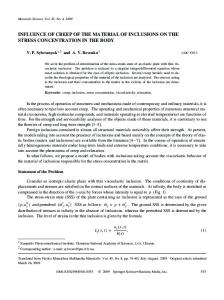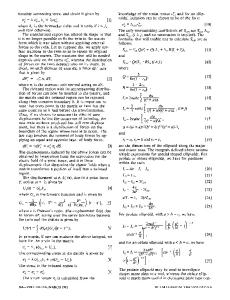Stress concentration near nonlinearly deformed thin inclusions
- PDF / 456,945 Bytes
- 6 Pages / 595.276 x 793.701 pts Page_size
- 106 Downloads / 346 Views
STRESS CONCENTRATION NEAR NONLINEARLY DEFORMED THIN INCLUSIONS V. P. Sylovanyuk and N. A. Ivantyshyn
UDC 539.3
We determine the stress concentration near a thin elliptic inclusion made of a material deformed beyond the limits of linear elasticity. It is shown that the nonlinearity of the material of the inclusion strongly affects the stressed state of the matrix.
Foreign inclusions present in almost all structural materials strongly affect their operating properties. For the analysis of the role played by these inclusions, parallel with experiments, it is customary to use theoretical models of inhomogeneities in the materials based, as a rule, on the concepts of the theory of elastic bodies for the matrix and the inclusions [1–4]. In analyzing the influence of inclusions on the strength properties and fracture of materials, it is often necessary to take into account the nonlinearity of the relationship between strains and stresses. In what follows, we propose a model of bodies with inclusions in which the material of inclusions can be physically nonlinear. By using this approach, one can estimate the limits of applicability of the linear models of inclusions and the levels of loads for which it is necessary to use nonlinear models. Statement of the Problem and Model Relations Consider an isotropic elastic plate containing a thin elliptic inclusion. The materials of the matrix and the inclusion are in perfect contact, i.e., the conditions of continuity of displacements and stresses are satisfied on the surface of the inclusion V. We introduce a Cartesian coordinate system x, y as shown in Fig. 1. At infinity, the body is stretched and compressed in the direction of the y-axis by forces with intensity p. If the stiffness of the inclusion is lower or comparable with the stiffness of the base material, its physicomechanical properties can be approximately described via the properties of a set of continuously located vertical rods. Assume that the material of the inclusion deformed beyond the limit of elasticity obeys the following law (Fig. 2): σy = σ y
⎛ εy ⎞ m , ⎝ εT ⎠
(1)
where εT is the level of strains in the material of the inclusion corresponding to the yield stress, σy is the yield strength of the material, and m (0 ≤ m ≤ 1) is the strain-hardening exponent. The process of deformation of these inclusions is described by the formula Karpenko Physicomechanical Institute, Ukrainian Academy of Sciences, Lviv, Ukraine. Translated from Fizyko-Khimichna Mekhanika Materialiv, Vol. 44, No. 4, pp. 35–38, July – August, 2008. Original article submitted November 27, 2007. 500
1068–820X/08/4404–0500
© 2008
Springer Science+Business Media, Inc.
S TRESS CONCENTRATION NEAR NONLINEARLY DEFORMED THIN INCLUSIONS
501
Fig. 1. Schematic diagram of the inclusion and the choice of the coordinate system.
Fig. 2. Tensile stress–strain diagram for a smooth specimen made of the material of the inclusion.
εy =
u*( x ) , h( x )
(2)
where u* ( x ) are the displacements of points of the surface V along the y-axis and the bra
Data Loading...











